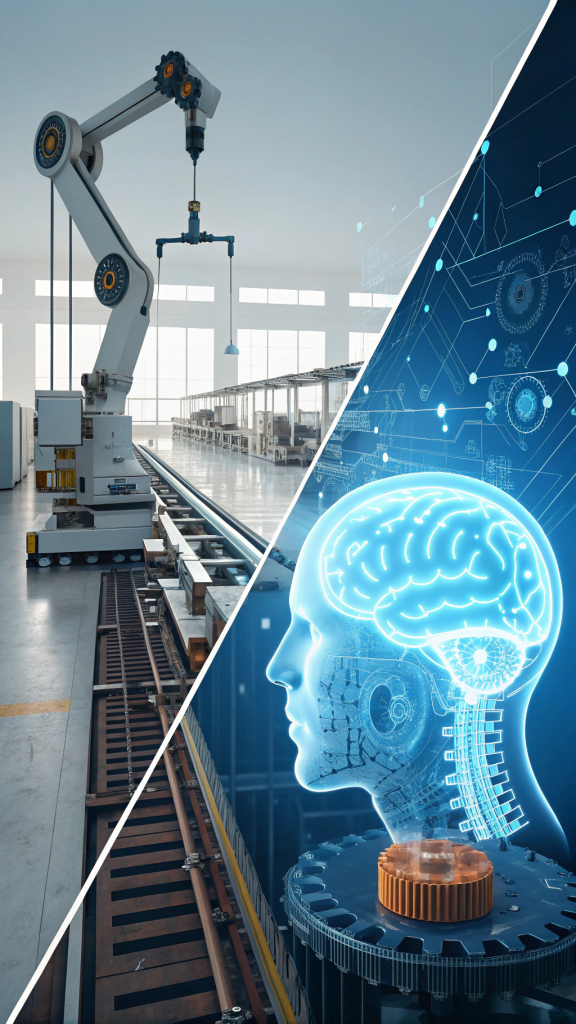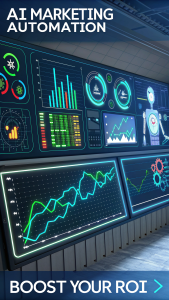Automation vs. AI

In today’s rapidly evolving technological landscape, “automation” and “artificial intelligence” (AI) are often used interchangeably, creating confusion about their distinct capabilities and applications. While both technologies aim to improve efficiency and productivity, they operate on fundamentally different principles. Understanding the nuances of automation vs. AI is crucial for businesses seeking to leverage their transformative power. This blog post will delve into the core differences between these two powerful technologies, exploring their unique strengths, limitations, and how they can synergistically work together to drive innovation and optimize operations. We’ll also explore real-world examples and help you determine the right technology for your specific business needs. Let’s unravel the mysteries and discover the potential of automation and AI.
Automation vs. AI: What’s the Difference?
Defining Automation
Automation involves pre-programmed sequences of actions executed by machines or software to perform repetitive tasks. These rule-based processes are designed to follow specific instructions without human intervention. Automation focuses on streamlining predictable and well-defined workflows.
Examples of Automation
Common examples of automation include Robotic Process Automation (RPA), which automates routine computer tasks, industrial automation using robots for assembly lines, and marketing automation for sending targeted emails. These applications demonstrate the diverse range of tasks that can be automated.
Benefits of Automation
Automation offers several advantages, including increased efficiency by accelerating processes, reduced human error through consistent execution, and cost savings by minimizing labor costs. These benefits contribute to enhanced productivity and operational effectiveness.
Limitations of Automation
Despite its advantages, automation has limitations. It lacks the ability to adapt to changing conditions, handle complex or unstructured data, and make independent decisions. Automation excels in pre-defined tasks but struggles with variability.
Defining Artificial Intelligence
Artificial intelligence (AI) aims to mimic human intelligence, enabling machines to learn from data, reason, problem-solve, and adapt to new information. AI systems can analyze vast amounts of data, identify patterns, and make predictions or decisions.
Types of AI
Various types of AI exist, including machine learning, which allows systems to learn from data without explicit programming, deep learning, which uses artificial neural networks for complex pattern recognition, Natural Language Processing (NLP) for understanding and generating human language, and computer vision for interpreting images and videos. Each type of AI has specific applications.
Examples of AI
AI is used in diverse applications, such as chatbots for customer service, image recognition for medical diagnosis, and predictive analytics for forecasting market trends. These examples demonstrate the wide-ranging capabilities of AI across industries.
Benefits of AI
Artificial intelligence offers significant benefits, including improved decision-making through data-driven insights, enhanced customer experiences through personalized interactions, and innovation by enabling new products and services. AI empowers businesses to gain a competitive edge.
Limitations of AI
Artificial intelligence faces challenges such as data dependency, requiring large datasets for training, ethical concerns surrounding bias and fairness, and explainability, making it difficult to understand the reasoning behind AI decisions. These limitations are actively being addressed by researchers and developers.
How Automation and AI Work Together
Intelligent Automation (IA): The Synergistic Approach
Intelligent Automation (IA) combines the strengths of both automation and artificial intelligence. By integrating AI‘s cognitive abilities into automated processes, IA allows for more flexible, adaptable, and intelligent systems. This synergy creates powerful solutions for complex business challenges.
Real-world Examples of IA
Self-driving cars exemplify IA, using AI for decision-making and automation for controlling the vehicle. Personalized marketing campaigns leverage AI to tailor content and automation for delivery. Fraud detection systems utilize AI to identify suspicious patterns and automation to trigger alerts. These examples showcase the transformative potential of IA.
Benefits of Intelligent Automation
Intelligent Automation leads to improved productivity through optimized processes, increased agility by enabling quick adaptation to changing conditions, and enhanced customer satisfaction through personalized experiences. These benefits contribute to a more competitive and resilient business.
Automation vs. AI: Choosing the Right Technology for Your Business
Identifying Your Needs
Before implementing any technology, it’s essential to define your business objectives clearly. Identify the specific problems you aim to solve or the processes you want to improve. Understanding your needs is the first step in choosing the right technology.
Evaluating Existing Processes
Analyze your current workflows and identify pain points or bottlenecks. Assess which processes could benefit from automation or AI and prioritize based on potential impact and feasibility. A thorough evaluation is critical for effective implementation.
Considering Scalability and Flexibility
Think long-term and consider the scalability and flexibility of the chosen technology. Ensure that the solution can adapt to future growth and changing business requirements. Scalability and flexibility are crucial for maximizing return on investment.
Comparing Automation and AI Solutions
When comparing automation and AI solutions, consider factors like cost, implementation complexity, and expected ROI. Evaluate different vendors and their offerings to find the best fit for your specific needs. A comprehensive comparison is crucial for making informed decisions.
Cost Considerations
Implementing automation or AI involves costs related to software, hardware, integration, and maintenance. Assess the total cost of ownership and compare it to the potential benefits to determine the financial viability of the investment. Cost considerations are essential for budget planning.
Implementation Challenges
Implementing automation or AI can present challenges such as integrating with existing systems, data migration, and training employees. Anticipate these challenges and develop strategies to mitigate them. Addressing implementation challenges is key to successful adoption.
Return on Investment (ROI)
Measuring the ROI of automation and AI implementations is essential for evaluating their effectiveness. Define key performance indicators (KPIs) and track them regularly to assess the impact on business outcomes. ROI analysis helps justify the investment and optimize future strategies.
The Future of Automation and AI
Emerging Trends
The field of automation and AI is constantly evolving. Emerging trends like hyperautomation, which orchestrates multiple technologies for end-to-end automation, and the increasing role of AI in the metaverse, offer exciting possibilities for the future. Staying informed about these trends is crucial for businesses to remain competitive.
The Role of AI in the Metaverse
As the metaverse evolves, AI will play a critical role in creating immersive and interactive experiences. AI-powered virtual assistants, personalized avatars, and intelligent environments are just some of the possibilities. The intersection of AI and the metaverse holds immense potential for innovation.
The Impact on the Workforce
Automation and AI are transforming the workforce, creating new job opportunities while also displacing some existing roles. Reskilling and upskilling initiatives are essential to prepare the workforce for the future of work. Adapting to the changing job market is crucial for both individuals and organizations.
Conclusion: Embracing the Power of Automation and AI
Automation and artificial intelligence are powerful technologies that offer significant benefits for businesses across various industries. While automation excels at streamlining repetitive tasks, AI empowers machines to learn, reason, and adapt. The combination of these technologies through intelligent automation unlocks even greater potential for optimized processes, enhanced decision-making, and improved customer experiences. By understanding the key differences and synergies between automation and AI, businesses can make informed decisions about which technology to adopt and how to integrate them effectively to achieve their specific goals. Embracing the power of automation and AI is crucial for thriving in today’s dynamic business environment.
Frequently Asked Questions
What is the main difference between automation and AI?
Automation follows pre-programmed rules, while AI can learn and adapt from data.
Can automation and AI work together?
Yes, they can be combined through intelligent automation (IA) to create more powerful solutions.
What are some examples of AI applications?
Chatbots, image recognition, predictive analytics, and self-driving cars are some examples of AI applications.
What are the benefits of using automation?
Automation increases efficiency, reduces errors, and saves costs.
What are the limitations of AI?
AI can be data-dependent, face ethical concerns, and lack explainability.
How do I choose between automation and AI for my business?
Consider your business needs, existing processes, scalability requirements, and budget.
What is the future of automation and AI?
Emerging trends include hyper automation and the growing role of AI in the metaverse.
How will automation and AI impact the workforce?
They will create new job opportunities while also requiring reskilling and upskilling for some existing roles.
What is Robotic Process Automation (RPA)?
RPA is a type of automation that focuses on automating routine computer tasks.
What is machine learning?
Machine learning is a type of AI that allows systems to learn from data without explicit programming.
Ready to transform your business with the power of automation and AI? Explore our resources and contact us today to learn how we can help you implement these cutting-edge technologies to achieve your business objectives and stay ahead of the curve.


